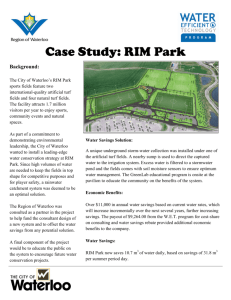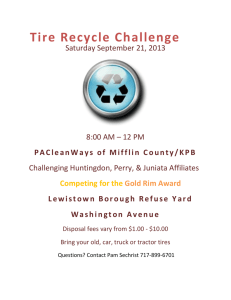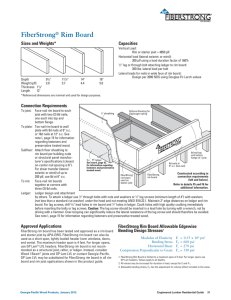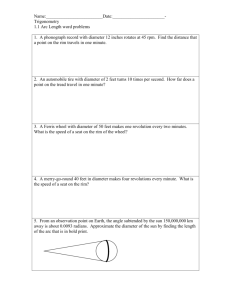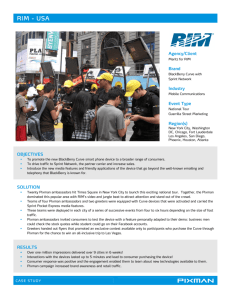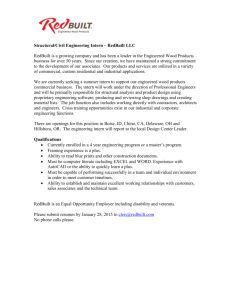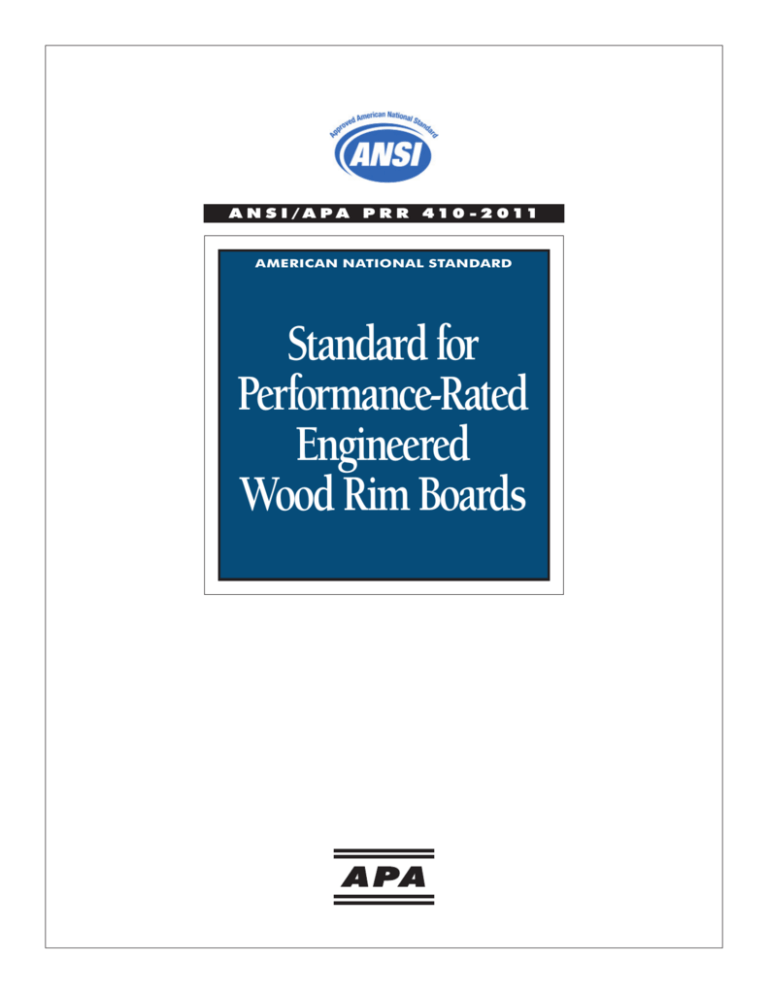
A N S I / A P A P R R 4 1 0 - 2 0 11
AMERICAN NATIONAL STANDARD
Standard for
Performance-Rated
Engineered
Wood Rim Boards
A M E RIC A N N ATION A L S TA N DA R D
Approval of an American National Standard requires review by ANSI that the requirements for due process,
consensus, and other criteria for approval have been met by the standards developer. Consensus is established
when, in the judgment of the ANSI Board of Standards Review, substantial agreement has been reached by
directly and materially affected interests. Substantial agreement means more than a simple majority, but not
necessarily unanimity. Consensus requires that all views and objections be considered, and that a concerted
effort be made towards their resolution. The use of American National Standards is completely voluntary; their
existence does not in any respect preclude anyone, whether he has approved the standards or not, from manufacturing, marketing, purchasing, or using products, processes, or procedures not conforming to the standards.
The American National Standards Institute does not develop standards and will in no circumstances give an
interpretation of any American National Standard. Moreover, no person shall have the right or authority to
issue an interpretation of an American National Standard in the name of the American National Standards
Institute. Requests for interpretations should be addressed to the secretariat or sponsor whose name appears
on the title page of this standard.
Caution Notice: This American National Standard may be revised or withdrawn at any time. The procedures
of the American National Standards Institute require that action be taken periodically to reaffirm, revise, or
withdraw this standard. Purchasers of American National Standards may receive current information on all
standards by calling or writing the American National Standards Institute.
American National Standards Institute
25 West 43rd Street, 4th Floor
New York, NY 10036
www.ansi.org
Published by
APA – The Engineered Wood Association
7011 South 19th Street
Tacoma, WA 98466
Copyright © 2011 by APA – The Engineered Wood Association
All rights reserved.
No part of this publication may be reproduced in any form, in an electronic retrieval system or otherwise,
without the prior written permission of the publisher.
Printed in the United States of America
A N S I / A P A P R R 4 1 0 - 2 0 11
AMERICAN NATIONAL STANDARD
Standard for
Performance-Rated
Engineered
Wood Rim Boards
APA – The Engineered Wood Association
Approved December 2, 2011
American National Standards Institute
FOR E WOR D (This Foreword is not a part of American National Standard ANSI/APA PRR 410-2011)
This Standard provides requirements and test methods for qualification and quality assurance for performancerated engineered wood rim boards, which are manufactured from wood structural panels, structural composite
lumber (SCL), or structural glued laminated timber (glulam) intended for use in construction applications.
Product performance classes are also specified.
This Standard was based on the Performance Standard for APA EWS Rim Boards, which has been published and
in use in North America since 1996. The development of this consensus American National Standard was
achieved by following the Operating Procedures for Development of Consensus Standards of APA – The Engineered
Wood Association, approved by the American National Standards Institute (ANSI).
Inquires or suggestions for improvement of this Standard should be directed to APA – The Engineered Wood
Association at 7011 South 19th Street, Tacoma, WA 98466, www.apawood.org.
CONTENTS
1.
SCOPE . . . . . . . . . . . . . . . . . . . . . . . . . . . . . . . . . . . . . . . . . 1
2.
REFERENCED DOCUMENTS . . . . . . . . . . . . . . . . . . . . . . . 1
2.1 ASTM Standards: . . . . . . . . . . . . . . . . . . . . . . . . . . . . 1
2.2 Other Standards: . . . . . . . . . . . . . . . . . . . . . . . . . . . . 2
3.
TERMINOLOGY. . . . . . . . . . . . . . . . . . . . . . . . . . . . . . . . . . 2
3.1
Definitions: . . . . . . . . . . . . . . . . . . . . . . . . . . . . . . . . 2
3.2 Description of Terms Specific to This Standard:. . . . . . 2
4.
DIMENSIONS AND DIMENSIONAL TOLERANCES . . . . . . 3
5.
REQUIRED PERFORMANCE CRITERIA . . . . . . . . . . . . . . . 4
5.1
Sampling . . . . . . . . . . . . . . . . . . . . . . . . . . . . . . . . . . 4
5.2 Structural Performance Criteria . . . . . . . . . . . . . . . . . 4
5.3 Edge Nailing Durability Criteria . . . . . . . . . . . . . . . . . 5
5.4 Physical Properties Criteria . . . . . . . . . . . . . . . . . . . . . 5
6.
TEST METHODS. . . . . . . . . . . . . . . . . . . . . . . . . . . . . . . . . . 5
6.1
General . . . . . . . . . . . . . . . . . . . . . . . . . . . . . . . . . . . 5
6.2 Test Method RB-1,
Horizontal (Shear) Load Transfer Capacity . . . . . . . . . 5
6.3 Test Method RB-2,
Uniform Vertical (Compression) Load Capacity . . . . . . 8
6.4 Test Method RB-3,
Lag Screw Lateral Resistance . . . . . . . . . . . . . . . . . . . 9
6.5 Test Method RB-4,
Concentrated Vertical Load Capacity . . . . . . . . . . . .10
6.6 Test Method RB-5,
Edge Nailing Durability. . . . . . . . . . . . . . . . . . . . . . . 11
7.
PRODUCT EVALUATION . . . . . . . . . . . . . . . . . . . . . . . . . 11
7.1
Qualification Tests . . . . . . . . . . . . . . . . . . . . . . . . . . 11
7.2
Mill Specification . . . . . . . . . . . . . . . . . . . . . . . . . . . 11
7.3
Trademarking and Certification . . . . . . . . . . . . . . . . 11
8.
QUALITY ASSURANCE. . . . . . . . . . . . . . . . . . . . . . . . . . . 12
8.1 Objective . . . . . . . . . . . . . . . . . . . . . . . . . . . . . . . . . 12
8.2 Referenced Standards. . . . . . . . . . . . . . . . . . . . . . . . 12
8.3 Mechanical and Physical
Property Quality Assurance . . . . . . . . . . . . . . . . . . . 13
ANNEX A. DESIGN PROPERTIES FOR
ANSI/APA PRR 410 ENGINEERED WOOD RIM BOARDS . . . 14
APPENDIX A. HISTORY OF STANDARD
(NON-MANDATORY). . . . . . . . . . . . . . . . . . . . . . . . . . . . . . . .15
APPENDIX B. ASD-TO-LSD CONVERSION
FACTORS (NON-MANDATORY) . . . . . . . . . . . . . . . . . . . . . . . 16
B1.
Horizontal Load Capacities (H). . . . . . . . . . . . . . . . . 16
B2. Uniform Vertical Load Capacities (V) . . . . . . . . . . . . 16
B3. Concentrated Vertical Load Capacities (P) . . . . . . . . 17
B4. Lag Screw Capacities (Z) . . . . . . . . . . . . . . . . . . . . . 17
ANSI/APA PRR 410-2011, Standard for Performance-Rated Engineered Wood Rim Boards
1.
SCOPE
1.1
An engineered wood rim board is a rectangular-shaped product manufactured from either structural-use panels sawn
into rim board dimensions, re-sawn structural glued laminated timber, or structural composite lumber manufactured
specifically to meet the performance requirements of rim boards in wood frame construction.
1.2
An engineered wood rim board shall have been qualified as meeting one or more of the referenced product
standards listed in Section 2. Proprietary wood rim board products are outside the scope of this standard and
shall be permitted to be qualified in accordance with ASTM D7672.
1.3
Unless otherwise specified, the term “engineered wood rim boards” referenced in this standard represents the
rim board products defined in Sections 1.1 through 1.2 and qualified under this standard.
1.4
This standard provides dimensions and tolerances, performance requirements, test methods, quality assurance,
and trademarking for engineered wood rim boards. The use of engineered rim boards in bending applications
is beyond the scope of this standard.
1.5
Engineered wood rim boards shall be used in dry service conditions where the mean equilibrium moisture
content of solid-sawn lumber is less than 16%.
1.6
Products carrying an engineered wood rim board trademark are to be used in accordance with the installation
requirements prescribed in the code or code report, and the recommendations published by the rim board
manufacturer, or its qualified agency or trade association.
1.7
The annex and discussion contained in this standard are mandatory, and notes and appendix are non-mandatory.
This standard incorporates the U.S. customary units as well as the International System of Units (SI). The values given
in the U.S. customary units are the standard and the SI values given in parentheses are for information only.
2.
R E F E R E NC E D DOC UM E NTS
1
This standard incorporates dated references. These normative references are cited at the appropriate places in
the text. Subsequent amendments or revisions to these references apply to this standard only when incorporated
into this standard by amendments or revisions.
2.1
ASTM Standards:
D9-09ae1 Standard Terminology Relating to Wood and Wood-Based Products
D198-09 Standard Test Methods of Static Tests of Lumber in Structural Sizes
D1037-06a Standard Test Methods for Evaluating Properties of Wood-Base Fiber and Particle Panel Materials
D2395-07ae1 Standard Test Methods for Specific Gravity of Wood and Wood-Base Materials
D2915-10 Sampling and Data-Analysis for Structural Wood and Wood-Based Products
D3501-05a Standard Test Methods for Wood-Based Structural Panels in Compression
D3737-09 Standard Practice for Establishing Stresses for Structural Glued Laminated Timber (Glulam)
D4761-05 Standard Test Methods for Mechanical Properties of Lumber and Wood-Based Structural Material
D5456-10a Standard Specification for Evaluation of Structural Composite Lumber Products
Form No. PRR 410A ■ © 2011 APA – The Engineered Wood Association ■ www.apawood.org
ANSI/APA PRR 410-2011, Standard for Performance-Rated Engineered Wood Rim Boards
2
D7672-11 Standard Specification for Evaluating Structural Capacities of Rim Board Products and Assemblies
F1667-11 Standard Specification for Driven Fasteners: Nails, Spikes, and Staples
2.2
Other Standards:
ANSI/AF&PA NDS-2005 National Design Specification for Wood Construction (NDS)
ANSI/AF&PA SDPWS-2008 Special Design Provisions for Wind and Seismic (SDPWS)
ANSI/AITC A190.1-2007 Structural Glued Laminated Timber
ANSI/ASME Standard B18.2.1-1996 Square and Hex Bolts and Screws (Inch Series)
APA D510-2008 Panel Design Specification
APA Y510-1997 Plywood Design Specification
CSA B111-1974 (R2003) Wire Nails, Spikes and Staples
CSA O86-09 Engineering Design in Wood
CSA O121-M1978 (R2003) Canadian Douglas Fir Plywood
CSA O122-06 Structural Glued-Laminated Timber
CSA O151-04 Canadian Softwood Plywood
CAN/CSA O325.0-07 Construction Sheathing
US Product Standard PS 1-09 Structural Plywood
US Product Standard PS 2-10 Performance Standard for Wood-Based Structural-Use Panels
3.
TE R M INOLOGY
3.1
Definitions:
See the referenced documents for definitions of terms used in this standard.
3.2
Description of Terms Specific to This Standard:
3.2.1 Composite Panel – Any panel containing a combination of veneer and other wood-based materials meeting
the requirements of PS 2 or CSA O325.
3.2.2 Horizontal (Shear) Load Transfer Capacity – The mechanical capacity of rim boards to transfer applied
lateral loads, such as wind or seismic, through shear load transfer provided by the connections between rim
board and floor sheathing, and rim board and sill plate.
3.2.3 Mat-Formed Panel – Any wood-based panel which does not contain veneer, consistent with the definition
of structural-use panels.
3.2.4 Mill Specification – A manufacturing specification based on product evaluation to be used for quality assurance purposes by the manufacturer and the qualified agency.
Form No. PRR 410A ■ © 2011 APA – The Engineered Wood Association ■ www.apawood.org
3
ANSI/APA PRR 410-2011, Standard for Performance-Rated Engineered Wood Rim Boards
3.2.5 Rim Board – A continuously supported, full-depth structural element developed for use within a wood floor
or roof assembly and performing a similar role as a starter or end joist when installed in a load bearing wall or
non-load bearing wall perpendicular or parallel to the joist framing to transfer horizontal (shear) and vertical
(compression) loads, provide attachment for diaphragm sheathing, siding and/or exterior deck ledgers, and
provide lateral support to floor or roof joists or rafters.
3.2.6 Structural Composite Lumber (SCL) – An engineered wood product that is intended for structural use and
bonded with adhesives, and meets the definition and requirements of ASTM D5456.
3.2.7 Structural Glued-Laminated Timber (glulam) – An engineered, stress rated product of a timber laminating
plant comprising assemblies of specially selected and prepared wood laminations securely bonded together
with adhesives, and meets the definition and requirements of ANSI/AITC A190.1 or CSA O122.
3.2.8 Structural-Use Panel – A panel product composed primarily of wood which, in its commodity end use, is
essentially dependent upon certain mechanical and/or physical properties for successful end-use performance
and meets the definition and requirements of PS 1, PS 2, CSA O325, CSA O121 or CSA O151.
3.2.9 Vertical (Compression) Load Capacity – The mechanical capacity of rim boards to transfer applied gravity
loads, such as wall loads, through compressive load transfer to the sill plate of the supporting wall.
4.
DI M E N S ION S A ND DI M E N S ION A L TOLE R A NC E S
4.1
The nominal thickness for engineered wood rim boards shall not be less than 1-1/4 inch (31.8 mm) for Rim
Board Grade A, 1-1/8 inches (28.6 mm) for Rim Board Grade B, or 1 inch (25.4 mm) for Grade C. Engineered
wood rim boards shall be identified by the Performance Category shown in Section 4.3.
4.2
The depth for engineered wood rim boards shall not exceed 24 inches (610 mm).
4.3
Dimensional tolerances – Dimension tolerances permitted at the time of manufacture for engineered wood rim
boards shall be as follows:
Depth – Plus 1/8 inch (3.2 mm) or minus 0 inch (measured to 1/32 inch or 0.79 mm) for structural-use panel
or structural composite lumber rim boards. Structural glued-laminated timber rim board shall be manufactured at a moisture content and depth to ensure that it meets these same tolerances over a range of application
moisture contents from 5 to 16%.
Note: To ensure compatibility with I-joists, the depth of rim boards manufactured from glulam should be based on a
moisture content of approximately 12%.
Thickness – Tolerances shall be in accordance with Table 1.
TABLE 1
THICKNESS TOLERANCES
Performance Category
1
1-1/8
1-1/4
Minimum Thickness(a)
0.950 inch
(24.13 mm)
1.069 inches
(27.15 mm)
1.188 inches
(30.16 mm)
Maximum Thickness
1.050 inches
(26.67 mm)
1.181 inches
(30.00 mm)
1.313 inches
(33.34 mm)
(a) The label thickness
Form No. PRR 410A ■ © 2011 APA – The Engineered Wood Association ■ www.apawood.org
4
ANSI/APA PRR 410-2011, Standard for Performance-Rated Engineered Wood Rim Boards
5.
REQUIRE D PE RFOR M A NC E C RITE RIA
Engineered wood rim boards shall meet the performance requirements established in this section.
5.1
Sampling
5.1.1 Test samples shall be representative of typical production and shall be sampled at the manufacturing facility
by a qualified agency.
5.1.2 For engineered wood rim boards manufactured from structural-use panels, a minimum of 20 full-size (typical
4 feet by 8 feet or 1219 mm by 2438 mm) panels shall be sampled for all evaluation tests. For engineered wood
rim boards manufactured from other materials, a total of at least 200 lineal feet (61,000 mm) taken from a
minimum of 2 different billets of representative production shall be sampled.
5.1.3 The sample size required for horizontal load transfer capacity, uniform vertical load capacity, lag screw tests, and
concentrated vertical load capacity shall be sufficient for estimating the population mean within 5% precision
with 75% confidence, or 10 assemblies, whichever is larger. In general, a sample size larger than 10 assemblies
is needed when the coefficient of variation is greater than 13%.
5.2
Structural Performance Criteria
5.2.1 The structural performance for engineered wood rim boards shall include the horizontal load transfer capacity, uniform vertical load capacity, 1/2-inch (12.7-mm) diameter lag screw lateral resistance, and concentrated
vertical load capacity of the product under evaluation.
5.2.2 Structural performance shall be evaluated for each engineered wood rim board thickness, depth, grade, and
species combination unless otherwise noted in the test method.
5.2.3 Engineered wood rim boards shall meet the minimum structural performance given in Table 2 based on the
test methods described in Section 6.
TABLE 2
REQUIRED MEAN TEST VALUES(a) AT AS-RECEIVED MOISTURE CONDITIONS FOR ENGINEERED WOOD
RIM BOARDS
H(c) (lbf/ft)
V(d) (lbf/ft)
Z(e) (lbf)
P(f) (lbf)
Depth(d) Limitation (in.)
Rim Board
Grade
Performance
Category(b)
d ≤ 24
d ≤ 16
16 < d ≤ 24
d ≤ 24
16 < d ≤ 24
A
1-1/4 or higher
675
15,450
9,600
2,190
10,500
B1
1-1/4 or higher
560
15,450
9,600
2,190
10,500
B2
1-1/8 or higher
560
14,550
9,600
2,190
10,500
C1
1-1/8 or higher
505
13,200
9,000
2,190
10,500
C2
1 or higher
505
9,900
4,950
1,875
10,500
For SI: 1 in. = 25.4 mm, 1 lbf/ft = 0.0146 N/mm, 1 lbf = 4.448 N
(a) The tabulated values are the required mean test values. The allowable stress design (for the U.S.) and limit states design (for
Canada) values are provided in Annex A.
(b) Performance categories as shown in Section 4.3.
(c) Mean test value for the horizontal (shear) load transfer capacity.
(d) Mean test value for the uniform vertical (compression) load capacity when qualified in accordance with Section 6.3 using specimens at as-received moisture conditions. The value shall be multiplied by 2.5/3.0 or 0.83 when qualified using specimens at
standard moisture conditions.
(e) Mean test value for the lateral resistance of a 1/2-inch (12.7-mm) diameter lag screw when qualified in accordance with Section
6.4 using specimens at as-received moisture conditions. The value shall be multiplied by 0.8 when qualified using specimens at
standard moisture conditions.
(f) Mean test value for the concentrated vertical load capacity when qualified in accordance with Section 6.5 using specimens at
as-received moisture conditions. The value shall be multiplied by 2.5/3.0 or 0.83 when qualified using specimens at standard
moisture conditions.
Form No. PRR 410A ■ © 2011 APA – The Engineered Wood Association ■ www.apawood.org
ANSI/APA PRR 410-2011, Standard for Performance-Rated Engineered Wood Rim Boards
5
5.3
Edge Nailing Durability Criteria
5.3.1 Samples used for evaluating the edge nailing durability of engineered wood rim boards shall be prepared from
those panels required in Section 5.1.2.
5.3.2 Tests shall be conducted in accordance with the procedures provided in Section 6.6.
5.3.3 The mean edge nailing durability shall be at least 75% of the mean horizontal load transfer capacity determined
from Section 6.2.
5.4
Physical Properties Criteria
5.4.1 Requirements specified in this section do not apply to plywood panels, laminated veneer lumber, or glulam
materials.
5.4.2 Samples used for establishing the physical properties of engineered wood rim boards shall be prepared from
those panels required in Section 5.1.2.
5.4.3 Thickness swell – The rim board thickness swell shall be evaluated based on the 24-hour water soak method
of ASTM D1037 using 5 specimens (6 inches by 6 inches or 152.4 mm by 152.4 mm) from each of 5 panels
(25 specimens in total) tested for structural performance (Section 5.2). The mean thickness swell for the whole
sample population shall not exceed 10% and no individual value shall exceed 12%.
5.4.4 Density – The rim board density shall be determined in accordance with ASTM D2395 using the same panels
tested for structural performance (Section 5.2). One specimen with a dimension of 6 inches (152.4 mm) by 6
inches (152.4 mm) shall be prepared from each panel (20 specimens in total) for the density determination
based on oven-dry weight and as-tested volume. Data obtained from this evaluation shall be used to establish
the control values for the quality assurance use (see Section 8.3.1.4).
5.4.5 Internal bond – The rim board internal bond shall be determined based on ASTM D1037 using 5 specimens
(2 inches by 2 inches or 50.8 mm by 50.8 mm) from each panel (100 specimens in total) tested for structural
performance (Section 5.2) except that the rim boards manufactured from SCL (excluding LVL) shall be evaluated based on ASTM D5456. Data obtained from this evaluation shall be used to establish the control values
for the quality assurance use (see Section 8.3.1.5).
6.
TE ST M ETHODS
6.1
General
6.1.1 Test methods provided in this section shall be used to establish the structural capacities of engineered wood
rim boards.
6.2
Test Method RB-1, Horizontal (Shear) Load Transfer Capacity
6.2.1 Specimen preparation
6.2.1.1 Horizontal (shear) load transfer capacity of engineered wood rim boards shall be determined using the assembly
consisting of rim board, sheathing, I-joists, and sill plate shown in Figure 1 for use in the U.S. and Figure 1A
for use in Canada.
Form No. PRR 410A ■ © 2011 APA – The Engineered Wood Association ■ www.apawood.org
6
ANSI/APA PRR 410-2011, Standard for Performance-Rated Engineered Wood Rim Boards
6.2.1.2 Dimensions for each component of the assembly shall meet the requirements shown in Table 3 for use in the
U.S and Canada. The sill plate shall be 2x4 spruce-pine-fir (SPF) with a specific gravity of no greater than 0.45
(i.e., 0.42 + 0.03) and comply with grading standards referenced in the applicable building code. The specific
gravity of the SPF shall be reported.
FIGURE 1
TEST ASSEMBLY FOR DETERMINING THE HORIZONTAL LOAD TRANSFER CAPACITY FOR USE IN THE U.S.
REA
CTI
ON
LOA
D
Fasteners are omitted for clarity. See Section 6.2.1.3.
FIGURE 1A
TEST ASSEMBLY FOR DETERMINING THE HORIZONTAL LOAD TRANSFER CAPACITY FOR USE IN CANADA
REA
CTI
ON
LOA
D
Fasteners are omitted for clarity. See Section 6.2.1.3.
Form No. PRR 410A ■ © 2011 APA – The Engineered Wood Association ■ www.apawood.org
7
ANSI/APA PRR 410-2011, Standard for Performance-Rated Engineered Wood Rim Boards
TABLE 3
MATERIAL DIMENSIONS
Material
Thickness (in.)
Depth or Width (in.)
Length (in.)
Rim Board
1 minimum
24 maximum
36
I-Joist
1-3/4 maximum
24 maximum
12
Sheathing (OSB)
23/32 maximum
12
39 minimum
Sill Plate(a) (SPF)
Nominal 2
Nominal 4
39 minimum
For SI: 1 in. = 25.4 mm
(a) Including the bottom plate for the Canadian assemblies.
6.2.1.3 Nailing schedules for the assembly shall follow the requirements provided in Table 4 for use in the U.S. and
Table 4A for use in Canada. The first and last nails between sheathing and rim board (edge nails) shall be 3
inches (76.2 mm) from each rim board end. Nails between sheathing and I-joist shall be 3 inches (76.2 mm)
from each I-joist end. The first and last toe nails between rim board and sill plate shall be 3 inches (76.2 mm)
from each rim board end. Nails used for the assembly shall be in conformance with ASTM F1667 for the U.S.
and CSA B111 for Canada.
TABLE 4
NAILING SCHEDULE FOR USE IN THE U.S.
Nailing
Sheathing to
Rim Board or Joist
Rim Board to
Sill Plates (Toe Nail)
Joist to
Sill Plate (Slanted)
Rim Board to
Joist
6 - 8d common
(0.131 in. x 2-1/2 in.)
@ 6 in. o.c.
6 - 8d box
(0.113 in. x 2-1/2 in.)
@ 6 in. o.c.
2 - 8d box
(0.113 in. x 2-1/2 in.)
2 - 8d box
(0.113 in. x 2-1/2 in.)
For SI: 1 in. = 25.4 mm
TABLE 4A
NAILING SCHEDULE FOR USE IN CANADA
Nailing
Sheathing to
Rim Board or Joist
6 - 6d common
(0.113 in. x 2 in.)
@ 6 in. o.c.
Bottom Plate
through Sheathing
to Rim Board(a)
Rim Board to
Sill Plates
(Toe Nail)
Joist to
Sill Plate
(Slanted)
Rim Board to
Joist
3 - 12d common
(0.148 in. x 3-1/4 in.)
@ 15.7 in. o.c.
or
6 - 12d common
(0.148 in. x 3-1/4 in.)
@ 6 in. o.c.(b)
6 - 12d common
(0.148 in. x 3-1/4 in.)
@ 6 in. o.c.
2 - 8d common
(0.131 in. x 2-1/2 in.)
2 - 8d common
(0.131 in. x 2-1/2 in.)
For SI: 1 in. = 25.4 mm
(a) 1/2 of the assemblies shall be prepared with a 3-1/4-in. (82-mm) nail installed between the 2-in. (51-mm) nails and the other
1/2 of the assemblies shall be prepared with a 3-1/4-in. (82-mm) nail installed within 0.4 in. (10 mm) of a 2-in. (51-mm) nail.
(b) For braced walls in high wind and seismic areas.
6.2.1.4 Joist spacing for the assembly shall be 24 inches (610 mm) on center.
6.2.1.5 The assembly shall be fabricated at least 12 hours prior to mechanical testing.
Form No. PRR 410A ■ © 2011 APA – The Engineered Wood Association ■ www.apawood.org
ANSI/APA PRR 410-2011, Standard for Performance-Rated Engineered Wood Rim Boards
8
6.2.2 Test procedures
6.2.2.1 Horizontal loads shall be applied through the sill plate while the sheathing reacts through full-width bearing, or vice versa. Vertical tie-rods or other similar devices shall be used to provide vertical restraints to avoid
overturning the assembly. These restraints, however, shall not interfere with the lateral displacement of the
assembly in the direction parallel to the loading.
6.2.2.2 Assembly displacements shall be measured based on the relative lateral displacements between the sill plate
and sheathing along the entire length of the rim board. Vertical displacements caused by overturning forces,
if any, shall be isolated from the measurements of lateral displacements.
6.2.2.3 The loading rate shall not exceed 450 lbf (2.0 kN) per minute.
6.2.2.4 The assembly shall be tested to the ultimate load or 0.4-inch (10.2 mm) lateral displacement, whichever occurs
first. No preload shall be applied. Load and displacement readings shall be taken at approximately equal load
increments.
Note: Testing beyond the 0.4-inch (10.2-mm) lateral displacement may provide additional information for some rim
board materials.
6.2.3 The maximum lateral load transfer capacity (test value) for each assembly is equal to the maximum load determined from Section 6.2.2.4 divided by the rim board length.
6.2.4 The lateral load transfer capacity determined from Section 6.2.3 is applicable to a shallower rim board of the
same thickness and species combination.
6.3
Test Method RB-2, Uniform Vertical (Compression) Load Capacity
6.3.1 Specimen preparation
6.3.1.1 Specimens used for this test method shall be at least 12 inches (305 mm) in length and tested as a standalone column. Specimens shall be tested after reaching an equilibrium moisture content at 65 ± 5% RH and
68 ± 11ºF (20 ± 6°C). Alternatively, specimens shall be permitted to be tested as received without moisture
conditioning provided that the higher load factor in 6.3.3 is used.
6.3.2 Test procedures
6.3.2.1 Vertical loads shall be applied uniformly over the entire length and thickness of the stand-alone rim board. No
lateral supports shall be used for testing. The loading direction shall be consistent with the intended application
of the rim board.
6.3.2.2 Vertical load deformations shall be measured based on the displacements over the entire depth (crosshead
movement).
6.3.2.3 The average time to failure shall be approximately two minutes.
6.3.2.4 A preload of no more than 10% of the estimated ultimate load is permitted to be applied and the deformation
reading zeroed. After that, the load and deformation readings shall be taken at approximately equal load increments until the ultimate load is reached.
6.3.2.5 The ultimate load and the load at 0.06-inch (1.5-mm) vertical deformation shall be recorded.
6.3.3 The maximum uniform vertical load capacity (test value) for each specimen is equal to the ultimate load determined from Section 6.3.2 divided by the rim board length, or 2.5 times the load at 0.06-inch (1.5-mm) vertical
displacement divided by the rim board length, whichever is less. When the specimen is tested as-received
Form No. PRR 410A ■ © 2011 APA – The Engineered Wood Association ■ www.apawood.org
9
ANSI/APA PRR 410-2011, Standard for Performance-Rated Engineered Wood Rim Boards
without moisture conditioning, the maximum uniform vertical load capacity (test value) for the specimen is
equal to the ultimate load determined from Section 6.3.2 divided by the rim board length, or 3 times the load
at 0.06-inch (1.5-mm) vertical displacement divided by the rim board length, whichever is less.
6.3.4 The buckling capacity for rim boards made with SCL and glulam shall be calculated in accordance with the
National Design Specification for Wood Construction (NDS) using the appropriate axial compressive stress and
bending modulus of elasticity in the perpendicular to the rim board length direction, as tested in accordance
with ASTM D3501 and D198, respectively. The buckling length coefficient, Ke, shall not be less than 0.90. The
maximum uniform vertical load capacity for the rim board shall be equal to the calculated buckling capacity
or the maximum uniform vertical load capacity determined from 6.3.3, whichever is less. The uniform vertical load capacity cannot exceed the compression perpendicular-to-grain capacity of the sheathing and plate
materials.
Note: The calculated buckling load capacity for structural-use panels is equal to or greater than the allowable value
shown in Table A1 based on the properties published in the Panel Design Specification and the allowable compressive
stress perpendicular to the grain of 360 psi for floor sheathing.
6.3.5 The uniform vertical load capacity determined from Section 6.3.4 is applicable to a shallower rim board of the
same thickness and species combination.
6.4
Test Method RB-3, Lag Screw Lateral Resistance
6.4.1 Specimen preparation
FIGURE 2
ASSEMBLY FOR DETERMINING THE LAG SCREW LATERAL RESISTANCE
Rim board thickness
4"(a)
1/2"
Connect
sheathing to
rim board using
6d box nails @
6" o.c. staggered
2 rows. Insert a
wax paper
between the
ledger and
sheathing.
Major
strength axis
Rim board
and sheathing
8"
Rim board
12"
1/2" Lag
screw with
washer
2"
2"
Ledger
For SI: 1 in. = 25.4 mm
Ledger
1-1/2"
Major
strength axis
1-1/2"
8"
(a) The dimension may be increased to avoid splitting provided the deviation is reported and noted in the specific Mill Specification.
Form No. PRR 410A ■ © 2011 APA – The Engineered Wood Association ■ www.apawood.org
ANSI/APA PRR 410-2011, Standard for Performance-Rated Engineered Wood Rim Boards
10
6.4.1.1 Specimens used for determining the lag screw lateral load resistance of engineered wood rim boards shall be prepared in accordance with Figure 2. Dimensions for each component of the assembly shall meet the requirements
shown in Figure 2. A wax paper shall be inserted between the ledger and sheathing to minimize friction.
Note: This test method is not intended for lag screw installation with multiple washer spacers between the head of the
lag screw and the ledger.
6.4.1.2 A 1/2-inch (12.7-mm) diameter lag screw with washer shall be used for testing. The lag screw used for the
assembly shall be in conformance with ANSI/ASME B18.2.1.
6.4.1.3 The ledger shall be 2x6 spruce-pine-fir (SPF) with a specific gravity of no greater than 0.45 (i.e., 0.42 + 0.03)
and comply with grading standards referenced in the applicable building code. The specific gravity of the SPF
shall be reported.
6.4.1.4 A clearance hole and lead hole shall be bored in accordance with the guidelines provided in the 2005 NDS.
The diameter for the lead hole shall be 5/16 inch (7.9 mm).
6.4.1.5 The assembly shall be fabricated at as-received conditions and conditioned at 65 ± 5% RH and 68 ± 11ºF
(20 ± 6°C) until reaching moisture equilibrium before mechanical testing. Alternatively, specimens shall be
permitted to be tested as-received without moisture conditioning provided that the required mean test values
in Table 2 are used.
6.4.2 Test procedures
6.4.2.1 Loads shall be applied through the ledger while the rim board and sheathing react through full-width bearing,
or vice versa.
6.4.2.2 Assembly displacements shall be measured based on the movement of the machine cross head.
6.4.2.3 The loading rate shall not exceed 0.1 inch (0.25 mm) per minute.
6.4.2.4 The assembly shall be tested up to the ultimate load or 1.5-inch (38-mm) displacement, whichever occurs first. No
preload shall be applied. Load and displacement readings shall be taken at approximately equal load increments.
6.4.3 The maximum lag screw lateral resistance (test value) for each assembly is equal to the maximum load determined from Section 6.4.2.4.
6.4.4 The lag screw lateral resistance determined from Section 6.4.3 is applicable to all rim boards of the same thickness and species combination.
6.5
Test Method RB-4, Concentrated Vertical Load Capacity
6.5.1 Specimen preparation
6.5.1.1 Specimens used for this test method shall be at least 16 inches (406 mm) in length and tested as a standalone column. Specimens shall be tested after reaching an equilibrium moisture content at 65 ± 5% RH and 68
± 11ºF (20 ± 6°C). Alternatively, specimens are permitted to be tested as-received without moisture conditioning provided that the higher load factor in 6.5.3 is used.
6.5.2 Test procedures
6.5.2.1 Test procedures shall follow Section 6.3.2 except that the concentrated vertical load shall be applied through a
4-1/2-inch (114-mm) long steel bar with a minimum thickness of 1/2 inch (12.7 mm) and a width of not less
than the rim board thickness. The steel bar shall be centered on the 16-inch (406-mm) specimen length.
Form No. PRR 410A ■ © 2011 APA – The Engineered Wood Association ■ www.apawood.org
ANSI/APA PRR 410-2011, Standard for Performance-Rated Engineered Wood Rim Boards
11
6.5.3 The maximum concentrated vertical load capacity (test value) for each specimen is equal to the ultimate load determined from Section 6.5.2, or 2.5 times the load at 0.06-inch (1.5-mm) vertical deformation, whichever is less. When
the specimen is tested as-received without moisture conditioning, the maximum concentrated vertical load capacity
(test value) for the specimen is equal to the ultimate load determined from Section 6.5.2 or 3 times the load at 0.06inch (1.5-mm) vertical displacement, whichever is less.
6.5.4 The concentrated vertical load capacity determined from Section 6.5.3 is applicable to a shallower rim board
of the same thickness and species combination.
6.6
Test Method RB-5, Edge Nailing Durability
6.6.1 Specimen preparation
6.6.1.1 Specimens used for this test method shall be prepared in accordance with Section 6.2.1. A minimum of 3
assemblies shall be tested for each rim board species, depth, and thickness combination.
6.6.1.2 The 24-hour water soak method of ASTM D1037 shall be applied to each rim board specimen before the test
assembly is fabricated. The test assembly shall be fabricated while the rim board specimen is still wet.
6.6.1.3 The assembly shall be redried to a moisture content comparable to the moisture content of the assemblies tested
in Section 6.2 before mechanical testing.
6.6.2 Test procedures
6.6.2.1 Test procedures shall follow Section 6.2.2.
6.6.3 The maximum edge nailing durability (test value) for each assembly is equal to the maximum load determined
from Section 6.6.2 divided by the rim board length.
6.6.4 The edge nailing durability determined from Section 6.6.3 is applicable to a shallower rim board of the same
thickness and species combination.
7.
PRODUCT E VA LUATION
7.1
Qualification Tests
Required qualification tests and criteria are detailed in Section 5 of this standard. Retesting shall be conducted
using a new independent sample set.
7.2
Mill Specification
Upon conformance with the requirements specified in this standard, a manufacturing specification unique to the
product and mill shall be written based on product evaluation. This specification shall be used for quality assurance
purposes by the manufacturer and the qualified agency. Product evaluation will be accomplished on the same lot
supplied by the manufacturer for qualification testing. Reference values shall be established during product evaluation or from applicable performance requirements in this standard, as specified in Section 8.
7.3
Trademarking and Certification
7.3.1 Certification
All engineered wood rim boards represented as being in conformance with this standard shall bear the stamp
of a qualified agency which (1) either inspects the manufacture or (2) has tested a random sampling of the
finished products in the shipment being certified for conformance with this standard.
Form No. PRR 410A ■ © 2011 APA – The Engineered Wood Association ■ www.apawood.org
ANSI/APA PRR 410-2011, Standard for Performance-Rated Engineered Wood Rim Boards
12
7.3.2 Qualified Agency
A qualified agency is defined to be one that:
a. has the facilities and trained technical personnel to verify that the grading, measuring, and other characteristics of the products as determined by inspection, sampling and testing conform to all of the applicable
requirements specified herein;
b. has developed procedures to be followed by agency personnel in performance of the inspection and testing;
c. has no financial interest in, or is not financially dependent upon, any single company manufacturing the
product being inspected or tested; and
d. is not owned, operated or controlled by any such company.
7.3.3 Product Marking
All engineered wood rim board products represented as conforming to this standard shall be identified with
marks giving the following information:
a. Rim Board Grade qualified in accordance with this standard.
b. The Performance Category
c. The labeled rim board thickness
d. The mill name or identification number
e. The qualified agency name or logo
f. The symbol of “ANSI/APA PRR 410” signifying conformance with this standard.
g. Any manufacturer’s designations which shall be separated from the grade-marks or trademarks of the qualified agency by not less than 6 inches (152 mm).
7.3.4 Voiding Marks
Engineered wood rim boards originally marked as conforming to this standard but subsequently rejected as
not conforming thereto shall have any reference to the standard obliterated or voided by the manufacturer.
Note: This can be performed by blocking out the stamp with permanent black ink or light sanding.
8.
8.1
QUA LIT Y A S S UR A NC E
Objective
This section is intended for use with an engineered wood rim board product that has qualified for trademarking
under this standard. The purpose of this section is to assure product quality by detecting changes in properties
which may adversely affect rim board performance. In all cases, the criteria to which the engineered wood rim
board is tested will be provided in the Mill Specification.
8.2 Referenced Standards
8.2.1 Engineered wood rim boards can be made from a variety of wood-based products, each with unique test
requirements. Quality assurance requirements exist in different forms for many of these products, as listed in
Section 2.
Form No. PRR 410A ■ © 2011 APA – The Engineered Wood Association ■ www.apawood.org
ANSI/APA PRR 410-2011, Standard for Performance-Rated Engineered Wood Rim Boards
13
8.2.2 Engineered wood rim board quality assurance requirements may be considered satisfied when the requirements
for the referenced standards in Section 2 and any additional requirements listed in Section 8.3 are met.
8.2.3 Referenced standards shall be specified by product type to define appropriate procedures and/or guidelines
for quality assurance. If a product trademarked under this standard is trademarked under another standard,
samples shall be taken for both standards.
8.3
Mechanical and Physical Property Quality Assurance
8.3.1 Mat-formed and composite panels
8.3.1.1 Mechanical properties – Dry bending strength and stiffness in both the along and across directions, and redry
(cycled in accordance with Section 7.16, Single Cycle Test, of PS 2) bending strength in the along direction (Section
7.6, Small Static Bending Test, of PS 2), of the product qualified under structural performance (Section 5.2 of this
standard) shall be established in accordance with PS 2 or CSA O325.
8.3.1.2 Glue bond durability shall be established based on tests conducted in accordance with Section 6.2.4.1 of PS 2
or CSA O325.
8.3.1.3 Thickness swell shall be tested for quality assurance. The mean thickness swell for the quality assurance sample
shall not exceed 10% and no individual value shall exceed 12%.
8.3.1.4 Density control value shall be established from qualification, as specified in Section 5.4.4. The minimum control
value shall be established as follows:
Minimum density = Mean density – 2.1 x standard deviation
For quality control purposes, the density based on weight and volume at typical environmental conditions of
the manufacturing facility shall be established.
8.3.1.5 Internal bond control value shall be established based on ASTM D1037 from qualification, as specified in Section
5.4.5. The minimum control value shall be established as follows:
Minimum internal bond = Mean internal bond – 2.1 x standard deviation
8.3.2 Plywood panels
8.3.2.1 Specification for species, thickness, and grade shall be established in accordance with PS 1, CSA O121, or
CSA O151.
8.3.2.2 Glue bond durability tests shall be conducted in accordance with Section 6.1.3 of PS 1 or equivalent sections in
CSA O121 or CSA O151.
8.3.3 Glulam
8.3.3.1 Specification for mechanical properties shall be established based on ANSI/AITC A190.1 and the principles set
forth in ASTM D3737.
8.3.3.2 Glue bond durability tests shall be conducted in accordance with Section 5.6.2 of ANSI/AITC A190.1.
8.3.4 Structural composite lumber
8.3.4.1 Control values for mechanical properties shall be established based on the principles set forth in ASTM D5456.
8.3.4.2 Glue bond durability tests shall be conducted in accordance with Section 10.4 of ASTM D5456.
Form No. PRR 410A ■ © 2011 APA – The Engineered Wood Association ■ www.apawood.org
14
ANSI/APA PRR 410-2011, Standard for Performance-Rated Engineered Wood Rim Boards
ANNE X A . DE SIGN PROPE RTIE S FOR
A N S I/A PA PR R 410 E NGINE E R E D WOOD RI M BOA R DS
TABLE A1
ALLOWABLE DESIGN VALUES(a) FOR ENGINEERED WOOD RIM BOARDS
H(c) (lbf/ft)
Rim Board
Grade
Performance
Category(b)
V(d) (lbf/ft)
Depth
(d)
d ≤ 24
d ≤ 16
Z(e) (lbf)
P(f) (lbf)
d ≤ 24
16 < d ≤ 24
Limitation (in.)
16 < d ≤ 24
A
1-1/4 or higher
240
5,150
3,200
350
3,500
B1
1-1/4 or higher
200
5,150
3,200
350
3,500
B2
1-1/8 or higher
200
4,850
3,200
350
3,500
C1
1-1/8 or higher
180
4,400
3,000
350
3,500
C2
1 or higher
180
3,300
1,650
300
3,500
For SI: 1 in. = 25.4 mm, 1 lbf/ft = 0.0146 N/mm, 1 lbf = 4.448 N
(a) The allowable values are the mean test values specified in Table 2 of this standard multiplied by the adjustment factor provided below:
Horizontal load transfer capacity (H): 1/2.8
Uniform vertical load capacity (V) and concentrated vertical load capacity (P): 1/2.5 for standard moisture conditioning or 1/3
for as-received moisture conditions
Lag screw lateral resistance (Z): 1/5 for standard moisture conditions or 1/6.25 for as-received moisture conditions
These design values are applicable only to rim board applications in compliance with the connection requirements tested in this
standard. All design values are applicable to the normal load duration (10 years) for wood products, except for the horizontal
load transfer capacity (H), which is based on the short-term load duration (10 minutes). Design values shall be adjusted for other
load durations in accordance with the applicable building code except that the uniform vertical (compression) load capacity (V)
and concentrated vertical load capacity (P) are not permitted to be increased for any load durations shorter than the normal
load duration (10 years). Toe-nailed connections are not limited by the 150 lbf/ft lateral load capacity noted for Seismic Design
Categories D, E and F in Section 4.1.7 of the SDPWS.
(b) Performance categories listed in this standard.
(c) H = The horizontal (shear) load transfer capacity based on the attachment schedule specified in this standard. This capacity
represents the total of the lateral loads transferred through the rim board by both the floor sheathing and wall plate above the
floor sheathing. H is based on qualification tests and is not subject to the limitations specified in Section 4.1.7 of the SDPWS. H is
permitted to be increased by a factor of 1.4 when subjected to wind loads.
(d) V = The uniform vertical (compression) load capacity, which shall be simultaneously satisfied along with the concentrated vertical
load capacity.
(e) Z = The lateral resistance of a 1/2-inch (12.7-mm) diameter lag screw in compliance with the connection requirements tested in
this standard.
(f) P = The concentrated vertical load capacity based on a 4-1/2-inch (114-mm) bearing length.
TABLE A1A
LIMIT STATES DESIGN VALUES(a) FOR ENGINEERED WOOD RIM BOARDS
ϕH(c) (lbf/ft)
ϕV(d) (lbf/ft)
Depth
(d)
ϕZ(e) (lbf)
ϕP(f) (lbf)
Limitation (in.)
Rim Board
Grade
Performance
Category(b)
d ≤ 24
d ≤ 16
16 < d ≤ 24
d ≤ 24
16 < d ≤ 24
A
1-1/4 or higher
313
8,590
5,338
584
5,838
B1
1-1/4 or higher
261
8,590
5,338
584
5,838
B2
1-1/8 or higher
261
8,090
5,338
584
5,838
C1
1-1/8 or higher
235
7,739
5,004
584
5,838
C2
1 or higher
235
5,504
2,752
500
5,838
For SI: 1 in. = 25.4 mm, 1 lbf/ft = 0.0146 N/mm, 1 lbf = 4.448 N
(a) These design values are applicable to standard-term load duration and permitted to be adjusted for other load durations in accordance with the applicable building code. Factors for ASD to LSD conversion are shown in Appendix B.
(b) Performance categories listed in this standard.
(c) H = The factored horizontal (shear) load transfer resistance based on the attachment schedule specified in this standard. This
capacity represents the total of the lateral loads transferred through the rim board by both the floor sheathing and wall plate
above the floor sheathing.
(d) V = The factored uniform vertical (compression) load resistance.
(e) Z = The factored lateral resistance of a 1/2-inch (12.7-mm) diameter lag screw in compliance with the connection requirements
tested in this standard.
(f) P = The factored concentrated vertical load resistance based on a 4-1/2-inch (114-mm) bearing length.
Form No. PRR 410A ■ © 2011 APA – The Engineered Wood Association ■ www.apawood.org
15
ANSI/APA PRR 410-2011, Standard for Performance-Rated Engineered Wood Rim Boards
A PPE NDI X A .
HI STORY OF STA NDA R D (NON- M A NDATORY )
In May 2009, the APA Standards Committee on Standard for Performance-Rated Engineered Wood Rim Boards
was formed to develop a national standard under the consensus processes accredited by the American National
Standards Institute (ANSI). This national consensus standard, designated as ANSI/APA PRR 410, is developed
based on the Performance Standard for APA EWS Rim Boards, APA PRR-401®, which has been in use by the engineered woods industry in North America since 1994.
The names of the ANSI/APA PRR 410 Committee members when the standard is published are as follows. The
current list of the committee membership is available from the committee secretariat upon request.
Name
Affiliation
Guy Anderson
Boise Cascade LLC
Mark Aucoin
Momentive Specialty Chemicals, Inc.
Zhaozhen Bao
TECO
Kevin Blau
Tolko Industries, Inc.
Zhiyong Cai
USDA Forest Products Lab
Dan Cheney
iLevel by Weyerhaeuser
Bruno Di Lenardo
Canadian Construction Materials Centre
Gary Ehrlich
NAHB
Bill Gareis
Ashland Chemical
Mark Hutnik
Huntsman
Joe Kaiserlik
Georgia-Pacific Corporation
Ken Lau
Ainsworth Lumber Company
John Marson
Norbord, Inc.
Edward Pacylowski
Pro-Built Construction, Inc.
Sheldon Shi
Mississippi State Univ.
Jason Smart
ICC Evaluation Service, Inc.
Darin Thompson
Timber Products Inspection, Inc.
Phil Vacca
Louisiana-Pacific Corporation
Randy Webb
PSI
Blair Wilding
Arclin
B.J. Yeh
APA – The Engineered Wood Association
Vice Chair
Chair
Secretariat
In 2011, the Standard Committee revised the standard for consistency with ASTM D7672, which applies to
proprietary wood rim board products.
Inquiries or suggestions for improvement of this standard should be directed to:
Secretariat, ANSI/APA PRR 410
APA – The Engineered Wood Association
7011 South 19th Street
Tacoma, WA 98466
www.apawood.org
PRR-401® is a registered trademark of APA – The Engineered Wood Association.
Form No. PRR 410A ■ © 2011 APA – The Engineered Wood Association ■ www.apawood.org
16
ANSI/APA PRR 410-2011, Standard for Performance-Rated Engineered Wood Rim Boards
A PPE NDI X B .
A S D -TO -L S D CON V E R S ION FACTOR S (NON- M A NDATORY )
B1. Horizontal Load Capacities (H)
Note: The conversion factor for rim board horizontal load capacities follows the same procedures used to convert the
shearwall values published in Clause 9 of CSA O86.
LSD: ϕK D,LSDHLSD,standard-term QQ
[B1-1]
ASD: H ASD,short-term Q
[B1-2]
where
ϕ
K D,LSD
Q
Q
HLSD,standard-term
H ASD,short-term
= resistance factor = 0.7 for nailed shearwalls and rim boards
= LSD load duration factor = 1.15 for LSD short-term loading
= LSD load factor = 1.5 for wind
= applied load
= LSD specified horizontal load capacity for LSD standard-term load duration
= ASD allowable horizontal load capacity for ASD short-term load duration
From Equations B1-1 and B1-2,
ϕH
LSD,standard-term
=
=
Q
K D,LSD
1.5
1.15
H ASD,short-term
H ASD,short-term
= 1.304 H ASD,short-term
[B1-3]
As a result, the conversion factor for the factored horizontal load capacities, ϕHLSD, is 1.304. Note that the converted ϕHLSD is based on LSD standard-term but not short-term load duration.
B2. Uniform Vertical Load Capacities (V)
LSD: ϕK D,LSDV LSD D QD + LQL
ASD: K D,ASDVASD QD + QL
[B2-1]
[B2-2]
where
ϕ
K D,LSD
V LSD
D
QD
L
QL
K D,ASD
VASD
= resistance factor = 0.95 for compression member
= LSD load duration factor = 1.0 for LSD standard-term loading
= LSD specified uniform vertical load capacity for standard-term load duration
= LSD dead load factor = 1.25
= applied dead load
= LSD live load factor = 1.5
= applied live load
= ASD load duration factor = 1.15 under roof snow load
= ASD allowable uniform vertical load capacity for ASD normal load duration
Form No. PRR 410A ■ © 2011 APA – The Engineered Wood Association ■ www.apawood.org
17
ANSI/APA PRR 410-2011, Standard for Performance-Rated Engineered Wood Rim Boards
Assuming QL /QD = , from Equations B2-1 and B2-2,
ϕV
LSD
=
D + L
K D,LSD (1 + )
K D,ASDVASD
[B2-3]
When calibrated to QL /QD = = 4.0 in accordance with the practice adopted by CSA O86,
ϕV
LSD
=
1.25 + 4 × 1.5
1.0 × (1 + 4)
= 1.668 VASD
× 1.15 × VASD
[B2-4]
For uniform vertical load capacities, a relative humidity effect factor of 0.85 that is applied to sheathing panels
to account for the difference in the relative humidity of 80% (the basis for CSA O86) and 65% (the standard
relative humidity for ASD) for structural-use panels given in CSA O86 is not required for rimboards due to the
location of the rimboard within the wall assembly. Therefore, the conversion factor for the factored uniform
vertical load capacities, ϕV LSD, is 1.668.
B3. Concentrated Vertical Load Capacities (P)
The conversion factor for the factored concentrated vertical load capacities, ϕPLSD, is the same as the factored
uniform vertical load capacities: 1.668.
B4. Lag Screw Capacities (Z)
The derivation of lag screw conversion factor follows the same procedures as the factored uniform vertical load
capacities, as shown in Equation B2-4. Therefore, the LSD factored lag screw capacities, ϕZLSD, are equal to
1.668 times the ASD lag screw capacities.
Form No. PRR 410A ■ © 2011 APA – The Engineered Wood Association ■ www.apawood.org
ANSI/APA PRR 410-2011,
Standard for Performance-Rated
Engineered Wood Rim Boards
A PA H E A D Q UA R TE R S
7011 So. 19th St. ■ Tacoma, Washington 98466 ■ (253) 565-6600 ■ Fax: (253) 565-7265
P RO D U C T SU P P O R T H E LP D E S K
(253) 620-7400 ■ E-mail Address: help@apawood.org
Form No. PRR 410A/Revised December 2011

